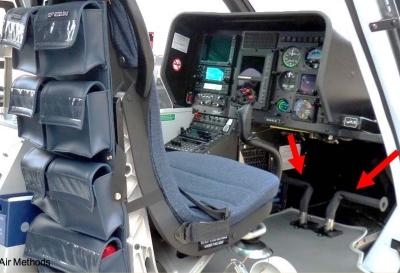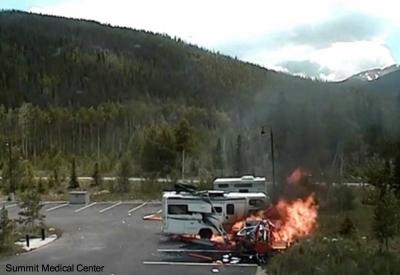Pilot Fatally Injured, Two Passengers Survived
The National Transportation Safety Board met on Tuesday, March 28, 2017 to determine the probable cause of a July 3, 2015, crash of an Airbus AS350 B3e helicopter during attempted lift off in Frisco, CO in which the helicopter pilot was fatally injured and two flight nurses were seriously injured.

The Airbus Helicopters AS350 B3e helicopter, N390LG, registered to and operated by Air Methods Corporation, lifted off from the Summit Medical Center Heliport, Frisco, Colorado, and then crashed into a parking lot; the impact point was located 360 feet southwest of the ground-based helipad. The pilot was fatally injured, and the two flight nurses were seriously injured. The helicopter was destroyed by impact forces and a postcrash fire. The flight was conducted under the provisions of 14 Code of Federal Regulations Part 135 on a company flight plan. Visual meteorological conditions prevailed at the time of the accident.
The AS350 B3e has a dual hydraulic system. The upper and lower hydraulic systems provide hydraulic assistance to the main rotor flight controls. This dual-hydraulic setup provides redundancy to the main rotor servo controls in case one of the hydraulic systems were to fail. The lower hydraulic system provides hydraulic assistance to the tail rotor flight controls. Because the tail rotor system has only a single-cylinder servo control, a yaw load compensator provides continuous hydraulic power assistance to the pedal controls in the event of a loss of pressure to the lower hydraulic system.
Operational procedures for the AS350 B3e required the pilot to perform a preflight hydraulic check to ensure that the yaw load compensator was functional. The steps of the check involved (1) moving the yaw servo hydraulic switch to the “OFF” position (which cuts off hydraulic pressure to the tail rotor hydraulic circuit) and then ensuring that pedal forces remained low; (2) depressing a test button on the cockpit center console, thereby releasing (depleting) the hydraulic pressure in the yaw load compensator accumulator by opening its solenoid valve, and then ensuring that loads were felt on the pedals; (3) resetting the test button, thereby closing the solenoid valve; and (4) restoring hydraulic pressure by moving the yaw servo hydraulic switch to the “ON” position.

The NTSB investigation determined that the pilot most likely did not return the yaw servo hydraulic switch to its “ON” position before takeoff, resulting in no hydraulic pressure in both the tail rotor servo control and the yaw load compensator accumulator, a lack of hydraulic boost to the pedals, and significantly increased pedal loads. Surveillance videos capturing the liftoff showed the helicopter yaw to the left and rotate counterclockwise several times before descending and impacting a recreational vehicle and the parking lot. Video evidence also showed that the pilot did not perform a hover check, as required by operational procedures, which could have allowed the pilot to verify the helicopter’s controllability.
The Board determined that the probable cause of this accident was Airbus Helicopters’ dual hydraulic AS350 B3e helicopter’s (1) preflight hydraulic check, which depleted hydraulic pressure in the tail rotor hydraulic circuit, and (2) lack of salient alerting to the pilot that hydraulic pressure was not restored before takeoff.
Such alerting might have cued the pilot to his failure to reset the yaw servo hydraulic switch to its correct position during the preflight hydraulic check, which resulted in a lack of hydraulic boost to the pedal controls, high pedal forces, and a subsequent loss of control after takeoff. Contributing to the accident was the pilot’s failure to perform a hover check after liftoff, which would have alerted him to the pedal control anomaly at an altitude that could have allowed him to safely land the helicopter. Contributing to the severity of the injuries was the helicopter’s fuel system, which was not crash resistant and facilitated a fuel-fed postcrash fire.
(Images from NTSB Abstract)
 ANN's Daily Aero-Term (04.20.24): Light Gun
ANN's Daily Aero-Term (04.20.24): Light Gun Aero-News: Quote of the Day (04.20.24)
Aero-News: Quote of the Day (04.20.24) ANN's Daily Aero-Linx (04.21.24)
ANN's Daily Aero-Linx (04.21.24) Aero-News: Quote of the Day (04.21.24)
Aero-News: Quote of the Day (04.21.24) ANN's Daily Aero-Term (04.21.24): Aircraft Conflict
ANN's Daily Aero-Term (04.21.24): Aircraft Conflict




